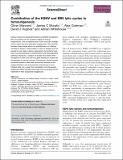Files in this item
Contribution of the KSHV and EBV lytic cycles to tumourigenesis
Item metadata
| dc.contributor.author | Manners, Oliver | |
| dc.contributor.author | Murphy, James | |
| dc.contributor.author | Coleman, Alex | |
| dc.contributor.author | Hughes, David J. | |
| dc.contributor.author | Whitehouse, Adrian | |
| dc.date.accessioned | 2018-10-03T16:30:07Z | |
| dc.date.available | 2018-10-03T16:30:07Z | |
| dc.date.issued | 2018-10 | |
| dc.identifier | 255853298 | |
| dc.identifier | 9a3c5fc8-4cbd-4717-9022-8fa190f1aacb | |
| dc.identifier | 85054017581 | |
| dc.identifier | 000452930300010 | |
| dc.identifier.citation | Manners , O , Murphy , J , Coleman , A , Hughes , D J & Whitehouse , A 2018 , ' Contribution of the KSHV and EBV lytic cycles to tumourigenesis ' , Current Opinion in Virology , vol. 32 , pp. 60-70 . https://doi.org/10.1016/j.coviro.2018.08.014 | en |
| dc.identifier.issn | 1879-6257 | |
| dc.identifier.uri | https://hdl.handle.net/10023/16138 | |
| dc.description | Research in the Whitehouse laboratory is supported in parts by funding from Biotechnology and Biological Sciences Research Council (BB/M006557/1, BB/N014405/1), Medical Research Council (MR/R010145/1, 95505168), Worldwide Cancer Research (16-1025), Wellcome Trust (203826/Z/16/Z) and Rosetrees Trust (M662). | en |
| dc.description.abstract | Kaposi’s Sarcoma-associated herpesvirus (KSHV) and Epstein Barr virus (EBV) are the causative agents of several malignancies. Like all herpesviruses, KSHV and EBV undergo distinct latent and lytic replication programmes. The transition between these states allows the establishment of a lifelong persistent infection, dissemination to sites of disease and the spread to new hosts. Latency-associated viral proteins have been well characterised in transformation and tumourigenesis pathways; however, a number of studies have shown that abrogation of KSHV and EBV lytic gene expression impairs the oncogenesis of several cancers. Furthermore, several lytically expressed proteins have been functionally tethered to the angioproliferative and anti-apoptotic phenotypes of virus-infected cells. As a result, the investigation and therapeutic targeting of KSHV and EBV lytic cycles may be essential for the treatment of their associated malignancies. | |
| dc.format.extent | 681690 | |
| dc.language.iso | eng | |
| dc.relation.ispartof | Current Opinion in Virology | en |
| dc.subject | Virus | en |
| dc.subject | Oncogenic viruses | en |
| dc.subject | Lytic | en |
| dc.subject | Gammaherpesvirus | en |
| dc.subject | Kaposis-sarcoma | en |
| dc.subject | QR355 Virology | en |
| dc.subject | RC0254 Neoplasms. Tumors. Oncology (including Cancer) | en |
| dc.subject | SDG 3 - Good Health and Well-being | en |
| dc.subject.lcc | QR355 | en |
| dc.subject.lcc | RC0254 | en |
| dc.title | Contribution of the KSHV and EBV lytic cycles to tumourigenesis | en |
| dc.type | Journal item | en |
| dc.contributor.institution | University of St Andrews. Biomedical Sciences Research Complex | en |
| dc.contributor.institution | University of St Andrews. School of Biology | en |
| dc.identifier.doi | https://doi.org/10.1016/j.coviro.2018.08.014 | |
| dc.description.status | Peer reviewed | en |
| dc.identifier.url | https://authors.elsevier.com/sd/article/S1879625718300920 | en |
This item appears in the following Collection(s)
Items in the St Andrews Research Repository are protected by copyright, with all rights reserved, unless otherwise indicated.

